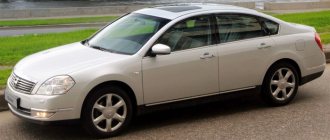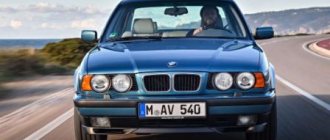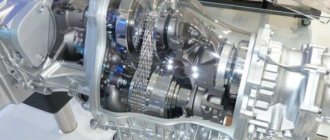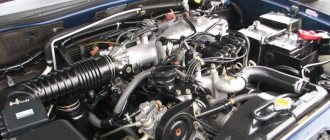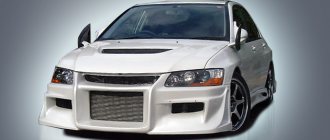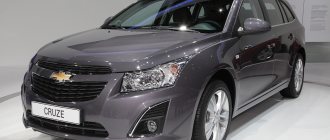The Lancer model appeared in the Mitsubishi range in 1972 and is now in its tenth generation. Lancer never gained popularity in Europe. The thing is that this car never stood out in any way and did not offer anything that cheaper and more popular competitors could. The Japanese were no strangers to shortcomings. Even the modern Lancer, despite its impressiveness, plays the role of a gray mouse in its segment.
Model history
The Mitsubishi Lancer 9 debuted in 2000, but it appeared on the European continent only three years later. In 2005, the Japanese underwent a light facelift, during which the front part and interior were updated (the ventilation system control unit was moved lower). There are many more such small changes, but they are not so significant and almost unnoticeable.
Depending on the engine version, equipment and destination market, the body may differ slightly even among copies of the same year of manufacture. Mass production of the car was completed in 2007, but for some countries small-scale assembly was still ongoing. In particular, in Russia, sales of the ninth generation model resumed in 2009 under the name Lancer Classic and continued until the beginning of 2011.
Body
The 3-volume four-door sedan is usually classified as class “C”. The car's creators paid special attention to safety, taking into account the failures of the previous Lancer, whose sales partially failed due to this parameter. As a result, Lancer 9 received a unique body, modernized at several points. In addition, it was additionally reinforced with stiffeners in the doors and sidewalls.
The Lancer 9 body is also good in terms of reliability against through corrosion. MMC gave a 12-year warranty on the hardware.
For the sake of the same safety, the front, rear and side body panels of the car received a programmed degree of deformation. During accidents and collisions, they deformed, absorbing the energy of the shock wave and preventing it from penetrating into the cabin.
As for the dimensions, the Lancer 9 also falls into the golf class. It is both compact and quite spacious. The length of the sedan body is 4535 mm, width – 1715 mm, and height – 1445 mm. The ground clearance is not small - 165 mm.
Dimensions of trunks of station wagon and sedan
Read more about the Lancer 9 body here .
Peculiarities
It's essentially a regular compact, but a little different than the others. It was never offered as a hatchback, which was one of the reasons for the lack of interest in Europe.
Mitsubishi Lancer has a fairly long wheelbase - 2600 mm. Like modern Golf cars, Lancer 9 is quite spacious inside. Even rear seat passengers can't complain about the lack of space. The 430-litre trunk won't disappoint either.
Lancer, apart from the independent rear suspension, does not stand out from its competitors in anything special. When creating it, fairly simple design solutions were used. Even the independent rear suspension is simple compared to similar designs. It’s better to forget about advanced multimedia systems right away.
The front panel is so primitive that it seems that the stylists were devoid of imagination. But for those who value simplicity, you won't find a better dashboard in this segment.
Due to the small number of switches, it seems that the car is very poorly equipped. Mitsubishi offered only the bare minimum: two airbags, electrically operated windows and mirrors, and air conditioning. There was also ABS. However, in the sports version you will be fascinated by the steering wheel, aluminum inserts, real sports indicators from the Evo version, leather upholstery and very comfortable seats with developed lateral support.
The biggest advantage of this car is its obedience on the road. There is an opinion among drivers that the Lancer behaves so well that the ESP system is a waste of money. Few people know that in independent tests, the Japanese sedan proved to be no worse than the reference Ford Focus. Unfortunately, it cannot compare with the Focus in terms of comfort. Although a lot depends on the version and configuration. The most interesting is the Sport version with a slightly lowered suspension and 16-inch low-profile tires. This car is relatively stiff, but it drives excellently.
Salon
Inside, everything is quite simple and without frills. The driver is greeted by a comfortable, three-spoke steering wheel and an almost flat center console. The latter has a climate system control unit, a CD radio, a pair of deflectors and additional sensors. On more advanced versions, a multimedia display may be located in the center.
On the instrument panel there are two main scales (speedometer and tachometer), located in separate “wells”. The panel is quite informative and not overloaded with unnecessary arrows. The ninth generation Lancer has a very spacious interior, as noted by the owners’ reviews. The rear seat can comfortably accommodate three adult passengers. However, the seats themselves are very hard and do not have much lateral support. Many people also complain about the plastic. It is quite hard and makes a lot of noise when the road surface is uneven. Only additional pasting with vibroplast saves the situation. By the way, finding the necessary interior part if it is damaged is not a problem. Nowadays there are many Lancers on sale, where you can buy an original part with minimal wear and tear for reasonable money.
Engines
The European Mitsubishi Lancer was equipped with three gasoline engines with a displacement of 1.3, 1.6 and 2.0 liters. The smallest motor is a real misunderstanding. Even the 1.6-liter unit with 98 hp. does not allow you to confidently move on the highway. In addition, it consumes no less fuel than a 2-liter naturally aspirated one. 2.0 DOHC with 135 hp output. one of the best engines in Mitsubishi history.
In addition to these units, the Lancer was available in the US and Japan with 1.5 L, 1.8 L and 2.4 L engines equipped with MIVEC variable valve timing. Diesel engines are completely absent from the model’s range.
Power units, for the most part, do not require attention, with the exception of regular replacement of fluids and filters, as well as flushing the throttle valve. Contamination that progresses over time leads to uneven engine idling. Sometimes the idle air control also fails. In some cases, an oil leak is detected through the crankshaft seals or the oil pump sealing ring.
Oxygen sensors (lambda probes), generator, starter and fuel pump fail at high mileage (after 200-300 thousand km). From time to time you have to deal with a faulty cooling system fan control unit (from 1,500 rubles for an analogue).
Motors easily exceed the mark of 400-500 thousand km. True, there is an opinion that the liquid cooling system pump is weak, or even the timing belt breaks. But this applies, first of all, to “thrifty” customers who want to service the car at the price of a Lada; they delay replacing the belt, and assess the condition of the pump by eye, although it needs to be changed along with the timing belt.
However, 1.6-liter engines often begin to eat up oil at 150-200 thousand km. Great luck if you managed to get away with just replacing the valve stem seals (5,000 rubles including labor). Most often, you also have to change the rings (20,000 rubles). And after 100-150 thousand km everything repeats itself. After the second replacement of the rings, major repairs are almost inevitable - 50-60 thousand rubles.
Sometimes the 1.3-liter naturally aspirated engine also fails. After 200-300 thousand km, wear of the camshaft cams is detected.
Transmission
Sometimes troubles also occur within the transmission. So, in a manual transmission paired with 1.6 and 1.3 engines, owners are faced with premature wear of the primary or secondary shaft bearings, and sometimes the differential bearings.
The clutch lasts a long time even in difficult conditions (more than 150-200 thousand km), and a good set will cost about 4-5 thousand rubles.
But a machine gun is quite difficult to kill.
How to make automatic trunk opening
To make car operation easier, you can automate the opening/closing of the trunk lid. You can add the function at a car service center or yourself in a garage.
You must first purchase it at any auto store or online:
- electric windows included - 2 pieces, within 2500 rubles;
- window closing module – 550 rubles;
- trunk opening button – 60 rubles.
The structure is connected according to a very simple scheme: the rear end of the window lift rail is attached to the crossbar behind the backrest. In the beam on which the glass is glued, a hole is made for an M6 nut and the ESP is screwed on.
In order for the opening/closing to take place fully and to avoid distortion of the lid, it is necessary to use exactly two electric windows. The operating button is installed on the remote control or in the cabin; by pressing it, the trunk closes or opens automatically. The castle also needs to be upgraded.
Chassis
In the chassis, you mainly have to change consumables. By 150-200 thousand km, the silent blocks and ball joints of the front arms wear out. The original lever costs astronomical money - from 17,000 rubles. Prices for analogues start at 1,600 rubles. It is worth recognizing that non-original levers significantly lose in durability - they last a little more than 40-50 thousand km. The rear levers will last more than 200-250 thousand km.
When replacing front control arms, difficulties often arise with the bolt securing the front silent block. The nut is fixed inside the subframe and is often turned. The service center immediately takes a grinder and cuts the subframe to gain access to the nut. Then the mechanics start welding and weld the hole. Subsequently, corrosion develops and the subframe becomes unusable. The cost of a new subframe is about 26,000 rubles, a used one in good condition is around 7,000 rubles. Another 7,000 rubles will be required for replacement work and toe adjustment.
Over time, the steering rack may leak or knock. The original rack will cost 39,000 rubles, and an analogue is available for 16,000 rubles. A specialized service center will charge about 9,000 rubles for repairs.
Owners also complain about brake discs that are too small in diameter and have insufficient resistance to overheating. After 200-250 thousand km, the brake caliper guides often turn sour, or the piston is attacked by corrosion. A repair kit with a piston can be purchased for 1,000 rubles.
Steering
The steering is rack and pinion type, supplemented by a hydraulic booster. At one time, the rack on the ninth Lancer caused a lot of complaints among motorists. The fact is that the control mechanism was very worn out inside. As a result, the rack leaked and constantly required repairs. Fortunately, now there are specialists who specialize in restoring the rack and pinion mechanism. The cost of repairs in the event of a breakdown will be up to 20 thousand rubles. A new rack for the ninth Lancer costs about 80 thousand rubles.
There are no problems with the brakes on the Lancer. Ventilated mechanisms are used at the front and simple disc mechanisms at the rear. By the way, the diameter of the disk was different. At the front it was 276 millimeters, and at the rear – 262. When replacing elements (and they wear down after 200 thousand kilometers), this must be taken into account. As for the pads, reviews do not recommend using cheap analogues. They wear out quickly and their service life does not correspond to the declared one. You should especially avoid pads with asbestos (white spots on the friction coating). They not only work poorly, but also emit a characteristic squeaking sound.
The Lancer also used an anti-lock wheel system and electronic brake force distribution. Over time, the sensors may drizzle. But in most cases, moisture and oxidized contacts are to blame.
Other problems and malfunctions
Lancer “loves” corrosion, but not excessively. Mitsubishi, like many Japanese manufacturers of the time, applied a very thin layer of poor quality varnish to the car. Therefore, numerous scratches, chips and corrosion of bare metal are quite an expected picture. However, few Lancers are painted in an expensive and rich color, and therefore cosmetic repairs will be inexpensive. More often the problems concern the rear wheel arches.
The materials used for interior decoration may seem unattractive and of low quality. But this is just an illusion. The resistance of interior parts to wear is high. The salon doesn't bother you with squeaks either.
In winter, the rear door locks often freeze. In the future, the lock actuators may fail. A new motor-actuator can be found for 300 rubles
After 150,000 km, the heater fan sometimes starts working only in the 4th speed position. The heater resistor fails (5,000 rubles). One of the reasons is the motor jamming due to contamination and lack of lubrication.
Soon you may also need to replace the steering column cable (from 1,500 rubles).
What to do if the trunk does not open
There are unpleasant moments when the trunk does not open and this can happen to anyone. First of all, many people complain that they cannot put the key in the lock. Most often, this problem is associated with the penetration of dirt into the area of the larva. In this case, you can try to treat the insides of the WD structure, but it is best to disassemble the system and clean it well from the inside.
If the lock is completely broken, then you will have to make your way to it from the interior, in order to make a complete replacement and unlock the lid, you must first carefully remove the trim.
During the cold season, the lock freezes and this can also cause it to be reluctant to open the first time. For such cases, it is advisable to always carry a special liquid with you to defrost the system. You can also place the car in a warm box/garage for 20 minutes and the problem will resolve itself.
It is best to resolve lock malfunctions immediately, so that in a critical situation when you need a jack, a canister, a spare tire, or tools, you do not have to break it or call an expensive tow truck.
Prices and availability of spare parts
Most parts are not expensive, but the car loves good quality substitutes. It's worth it, since the service life of the parts is much higher than in German or French models. It is better not to count on original spare parts; their prices are prohibitively high. A timing kit can be purchased for $40. But it is better to add 70-100 dollars and purchase quality elements along with the pump. The same applies to brake discs, steering rods and silent blocks of levers. Unfortunately, not all parts have good substitutes.
